Business in Practice Report: Tesco PLC Analysis and PESTEL
VerifiedAdded on 2022/11/30
|11
|3095
|427
Report
AI Summary
This report provides a comprehensive overview of business practices, covering various business sizes (micro, small, medium, and large) and organizational structures (sole trader, partnership, limited liability, public, and cooperative). It delves into the characteristics and examples of each, offering a detailed understanding of their operations. The report further examines different organizational structures and their impact on business productivity, specifically highlighting the hierarchical structure employed by Tesco PLC. A key component of the report involves a PESTEL analysis, which assesses the external factors influencing Tesco PLC's performance. The analysis explores how political, economic, social, technological, environmental, and legal factors affect the company's operations and strategic decisions, providing valuable insights into the external environment's impact on business success.
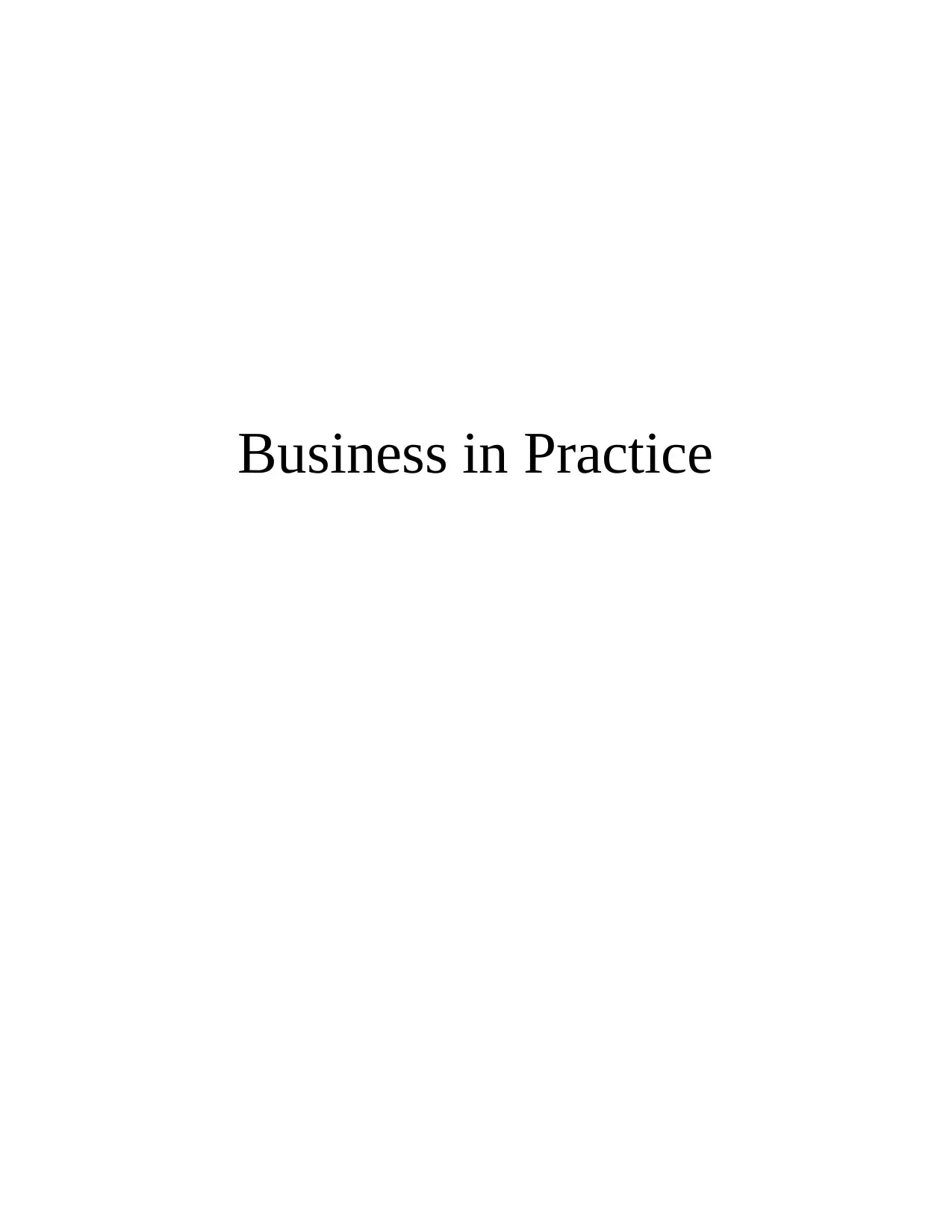
Business in Practice
Paraphrase This Document
Need a fresh take? Get an instant paraphrase of this document with our AI Paraphraser
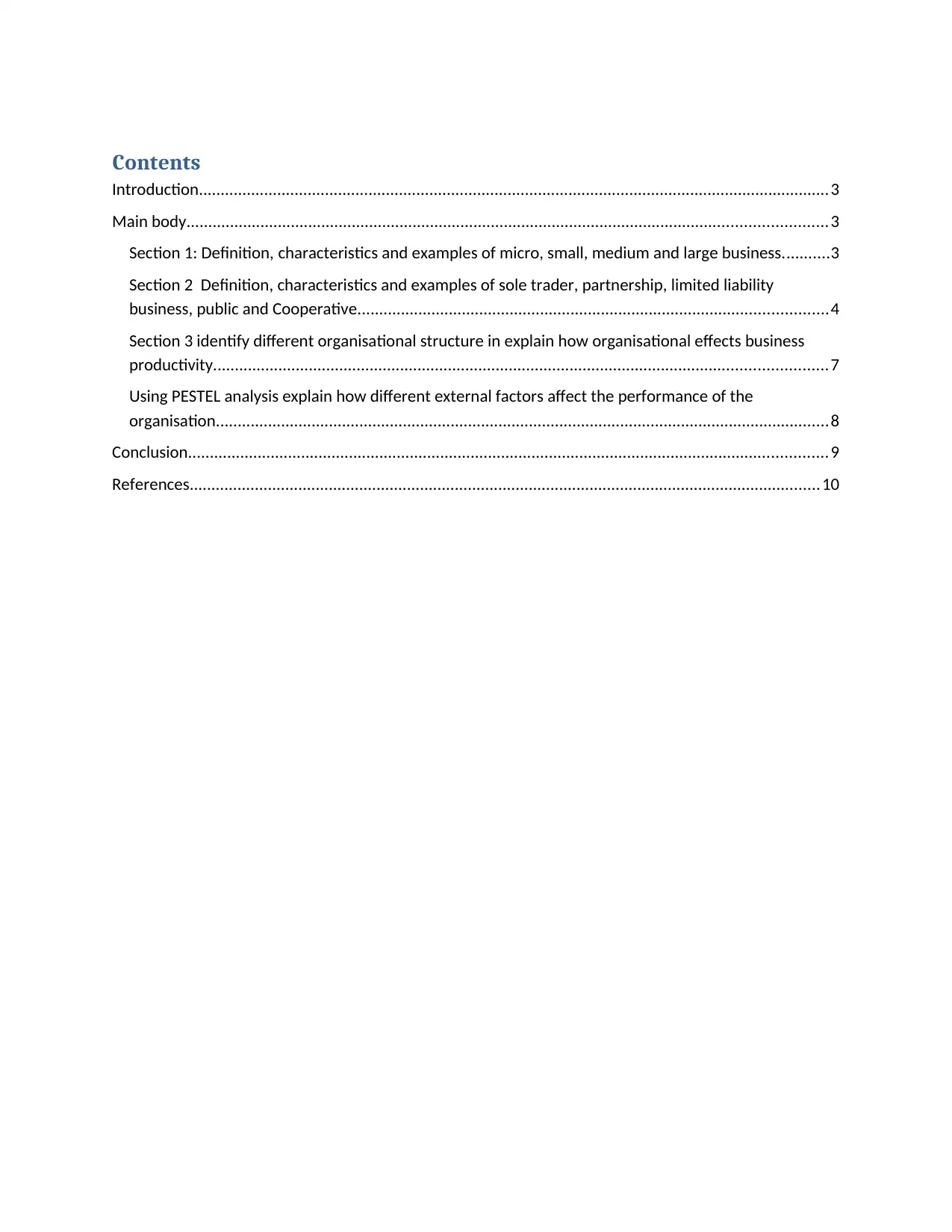
Contents
Introduction.................................................................................................................................................3
Main body...................................................................................................................................................3
Section 1: Definition, characteristics and examples of micro, small, medium and large business...........3
Section 2 Definition, characteristics and examples of sole trader, partnership, limited liability
business, public and Cooperative............................................................................................................4
Section 3 identify different organisational structure in explain how organisational effects business
productivity.............................................................................................................................................7
Using PESTEL analysis explain how different external factors affect the performance of the
organisation.............................................................................................................................................8
Conclusion...................................................................................................................................................9
References.................................................................................................................................................10
Introduction.................................................................................................................................................3
Main body...................................................................................................................................................3
Section 1: Definition, characteristics and examples of micro, small, medium and large business...........3
Section 2 Definition, characteristics and examples of sole trader, partnership, limited liability
business, public and Cooperative............................................................................................................4
Section 3 identify different organisational structure in explain how organisational effects business
productivity.............................................................................................................................................7
Using PESTEL analysis explain how different external factors affect the performance of the
organisation.............................................................................................................................................8
Conclusion...................................................................................................................................................9
References.................................................................................................................................................10
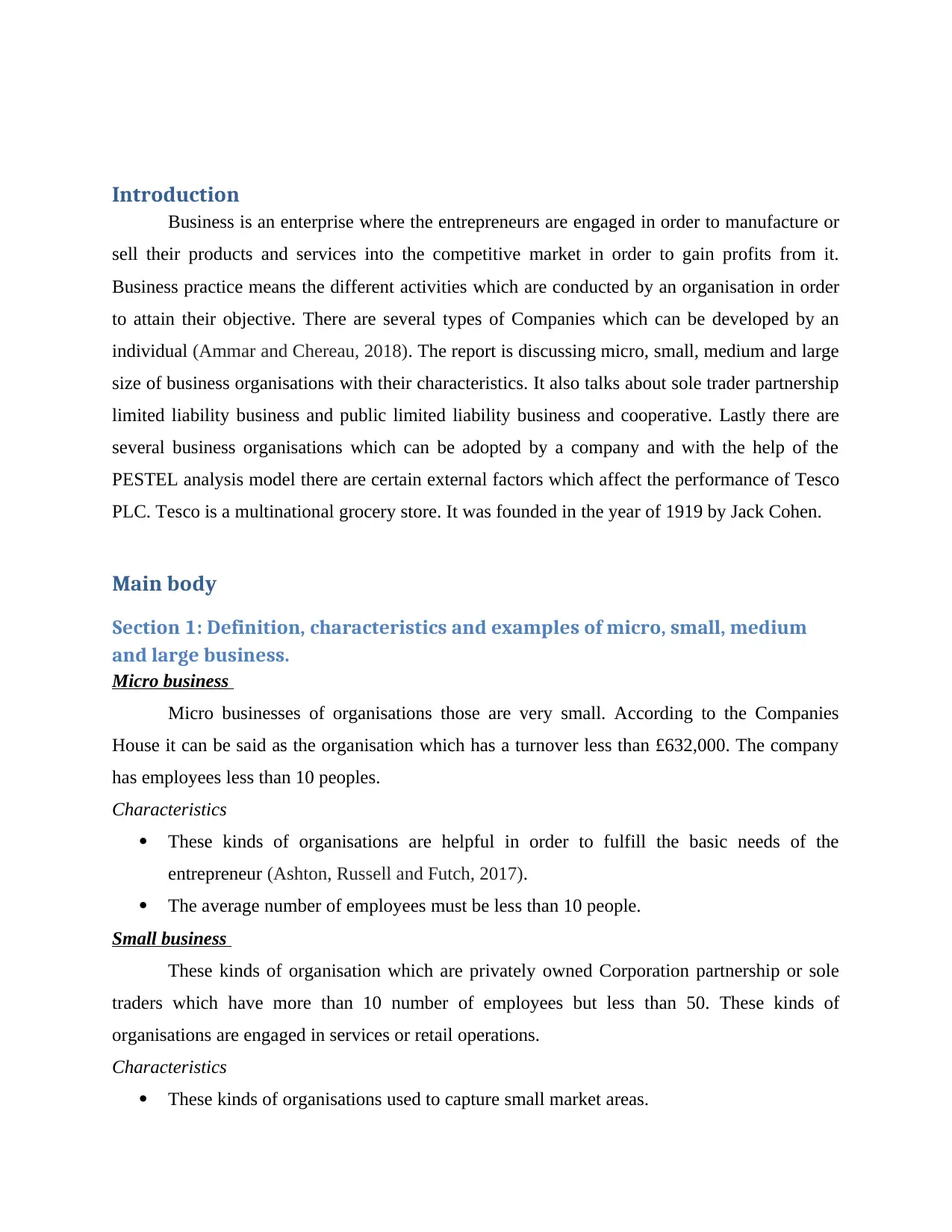
Introduction
Business is an enterprise where the entrepreneurs are engaged in order to manufacture or
sell their products and services into the competitive market in order to gain profits from it.
Business practice means the different activities which are conducted by an organisation in order
to attain their objective. There are several types of Companies which can be developed by an
individual (Ammar and Chereau, 2018). The report is discussing micro, small, medium and large
size of business organisations with their characteristics. It also talks about sole trader partnership
limited liability business and public limited liability business and cooperative. Lastly there are
several business organisations which can be adopted by a company and with the help of the
PESTEL analysis model there are certain external factors which affect the performance of Tesco
PLC. Tesco is a multinational grocery store. It was founded in the year of 1919 by Jack Cohen.
Main body
Section 1: Definition, characteristics and examples of micro, small, medium
and large business.
Micro business
Micro businesses of organisations those are very small. According to the Companies
House it can be said as the organisation which has a turnover less than £632,000. The company
has employees less than 10 peoples.
Characteristics
These kinds of organisations are helpful in order to fulfill the basic needs of the
entrepreneur (Ashton, Russell and Futch, 2017).
The average number of employees must be less than 10 people.
Small business
These kinds of organisation which are privately owned Corporation partnership or sole
traders which have more than 10 number of employees but less than 50. These kinds of
organisations are engaged in services or retail operations.
Characteristics
These kinds of organisations used to capture small market areas.
Business is an enterprise where the entrepreneurs are engaged in order to manufacture or
sell their products and services into the competitive market in order to gain profits from it.
Business practice means the different activities which are conducted by an organisation in order
to attain their objective. There are several types of Companies which can be developed by an
individual (Ammar and Chereau, 2018). The report is discussing micro, small, medium and large
size of business organisations with their characteristics. It also talks about sole trader partnership
limited liability business and public limited liability business and cooperative. Lastly there are
several business organisations which can be adopted by a company and with the help of the
PESTEL analysis model there are certain external factors which affect the performance of Tesco
PLC. Tesco is a multinational grocery store. It was founded in the year of 1919 by Jack Cohen.
Main body
Section 1: Definition, characteristics and examples of micro, small, medium
and large business.
Micro business
Micro businesses of organisations those are very small. According to the Companies
House it can be said as the organisation which has a turnover less than £632,000. The company
has employees less than 10 peoples.
Characteristics
These kinds of organisations are helpful in order to fulfill the basic needs of the
entrepreneur (Ashton, Russell and Futch, 2017).
The average number of employees must be less than 10 people.
Small business
These kinds of organisation which are privately owned Corporation partnership or sole
traders which have more than 10 number of employees but less than 50. These kinds of
organisations are engaged in services or retail operations.
Characteristics
These kinds of organisations used to capture small market areas.
⊘ This is a preview!⊘
Do you want full access?
Subscribe today to unlock all pages.

Trusted by 1+ million students worldwide

These are founded only in a limited area. 30 Company are not likely to have sale outlets
in multi States or countries.
For example grocery stores, small boutiques, saloons, Health and Care stores and many
others.
Medium size business
Medium sized businesses have employees less than 250 and the turnover is under £50
million.
Characteristics
These kinds of organisations have adopted more flexibility in order to change with
respect to the changing environment due to its sides and informal structure (Centobelli
and et. al., 2020). It is easy for search organisations to enjoy the one rebel in order to
grow with respect to the current situations.
These kinds of forms are managed and operated by the owners only and employees play
an important role in order to accomplish the targets.
The decision making power is vested by the owner only.
Large size of business organisation
These kinds of companies are at the global level. The annual revenue is more than £ 1
billion. They have more than 250 employees. The company has different staff in order to attain
their set goals in an effective manner (Cother and Cother, 2017). There are several offices for
locations which can be domestically and internationally.
Characteristics
These kinds of organisations generally play an important role in the development of an
economy as they provide a higher number of employment opportunities to the job seekers
(Dobrodolac and et. al., 2018).
These kinds of organisations are working in order to and profitability from the
competitive market.
For example: Tesco plc, Marks and Spencer and many others.
Section 2 Definition, characteristics and examples of sole trader, partnership,
limited liability business, public and Cooperative.
Sole trader
in multi States or countries.
For example grocery stores, small boutiques, saloons, Health and Care stores and many
others.
Medium size business
Medium sized businesses have employees less than 250 and the turnover is under £50
million.
Characteristics
These kinds of organisations have adopted more flexibility in order to change with
respect to the changing environment due to its sides and informal structure (Centobelli
and et. al., 2020). It is easy for search organisations to enjoy the one rebel in order to
grow with respect to the current situations.
These kinds of forms are managed and operated by the owners only and employees play
an important role in order to accomplish the targets.
The decision making power is vested by the owner only.
Large size of business organisation
These kinds of companies are at the global level. The annual revenue is more than £ 1
billion. They have more than 250 employees. The company has different staff in order to attain
their set goals in an effective manner (Cother and Cother, 2017). There are several offices for
locations which can be domestically and internationally.
Characteristics
These kinds of organisations generally play an important role in the development of an
economy as they provide a higher number of employment opportunities to the job seekers
(Dobrodolac and et. al., 2018).
These kinds of organisations are working in order to and profitability from the
competitive market.
For example: Tesco plc, Marks and Spencer and many others.
Section 2 Definition, characteristics and examples of sole trader, partnership,
limited liability business, public and Cooperative.
Sole trader
Paraphrase This Document
Need a fresh take? Get an instant paraphrase of this document with our AI Paraphraser
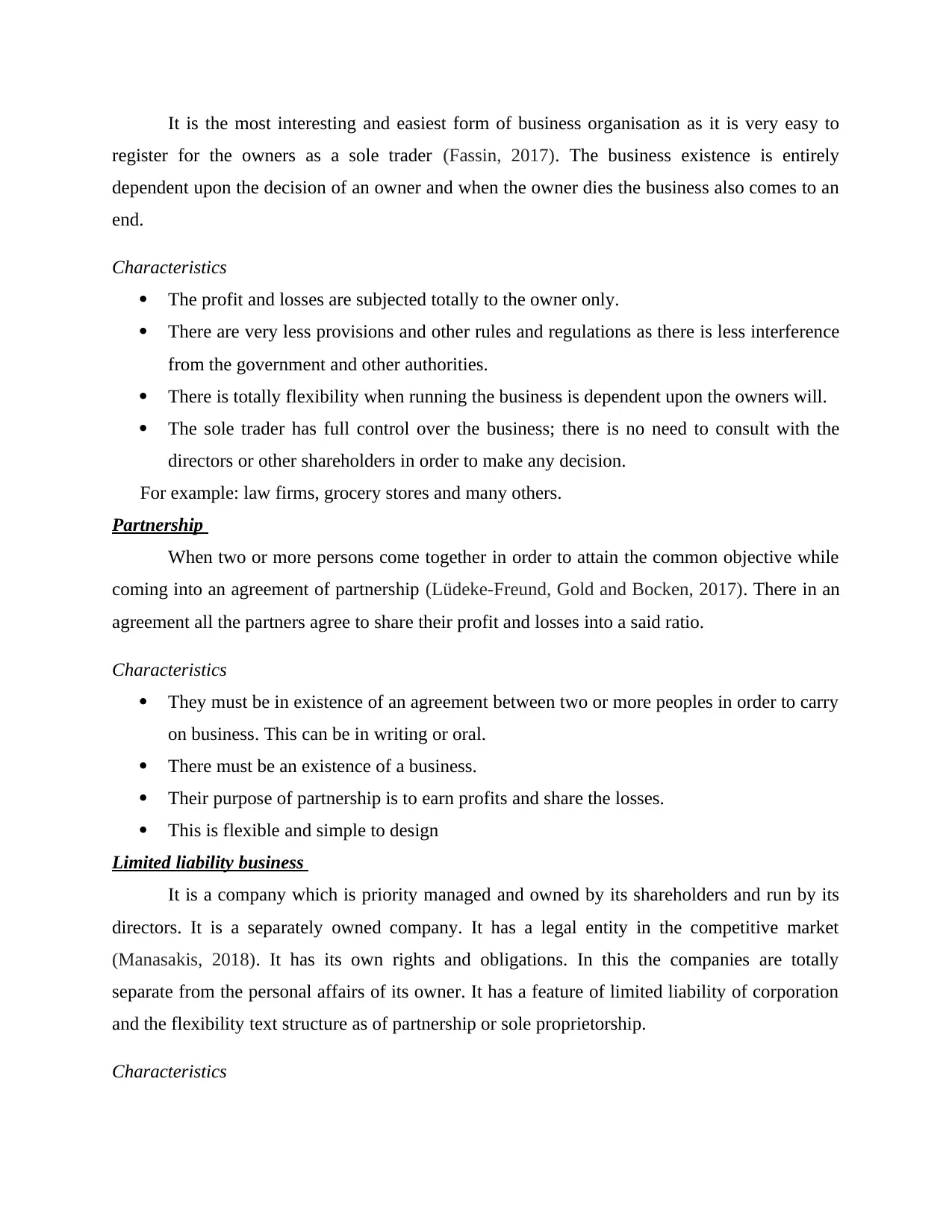
It is the most interesting and easiest form of business organisation as it is very easy to
register for the owners as a sole trader (Fassin, 2017). The business existence is entirely
dependent upon the decision of an owner and when the owner dies the business also comes to an
end.
Characteristics
The profit and losses are subjected totally to the owner only.
There are very less provisions and other rules and regulations as there is less interference
from the government and other authorities.
There is totally flexibility when running the business is dependent upon the owners will.
The sole trader has full control over the business; there is no need to consult with the
directors or other shareholders in order to make any decision.
For example: law firms, grocery stores and many others.
Partnership
When two or more persons come together in order to attain the common objective while
coming into an agreement of partnership (Lüdeke-Freund, Gold and Bocken, 2017). There in an
agreement all the partners agree to share their profit and losses into a said ratio.
Characteristics
They must be in existence of an agreement between two or more peoples in order to carry
on business. This can be in writing or oral.
There must be an existence of a business.
Their purpose of partnership is to earn profits and share the losses.
This is flexible and simple to design
Limited liability business
It is a company which is priority managed and owned by its shareholders and run by its
directors. It is a separately owned company. It has a legal entity in the competitive market
(Manasakis, 2018). It has its own rights and obligations. In this the companies are totally
separate from the personal affairs of its owner. It has a feature of limited liability of corporation
and the flexibility text structure as of partnership or sole proprietorship.
Characteristics
register for the owners as a sole trader (Fassin, 2017). The business existence is entirely
dependent upon the decision of an owner and when the owner dies the business also comes to an
end.
Characteristics
The profit and losses are subjected totally to the owner only.
There are very less provisions and other rules and regulations as there is less interference
from the government and other authorities.
There is totally flexibility when running the business is dependent upon the owners will.
The sole trader has full control over the business; there is no need to consult with the
directors or other shareholders in order to make any decision.
For example: law firms, grocery stores and many others.
Partnership
When two or more persons come together in order to attain the common objective while
coming into an agreement of partnership (Lüdeke-Freund, Gold and Bocken, 2017). There in an
agreement all the partners agree to share their profit and losses into a said ratio.
Characteristics
They must be in existence of an agreement between two or more peoples in order to carry
on business. This can be in writing or oral.
There must be an existence of a business.
Their purpose of partnership is to earn profits and share the losses.
This is flexible and simple to design
Limited liability business
It is a company which is priority managed and owned by its shareholders and run by its
directors. It is a separately owned company. It has a legal entity in the competitive market
(Manasakis, 2018). It has its own rights and obligations. In this the companies are totally
separate from the personal affairs of its owner. It has a feature of limited liability of corporation
and the flexibility text structure as of partnership or sole proprietorship.
Characteristics
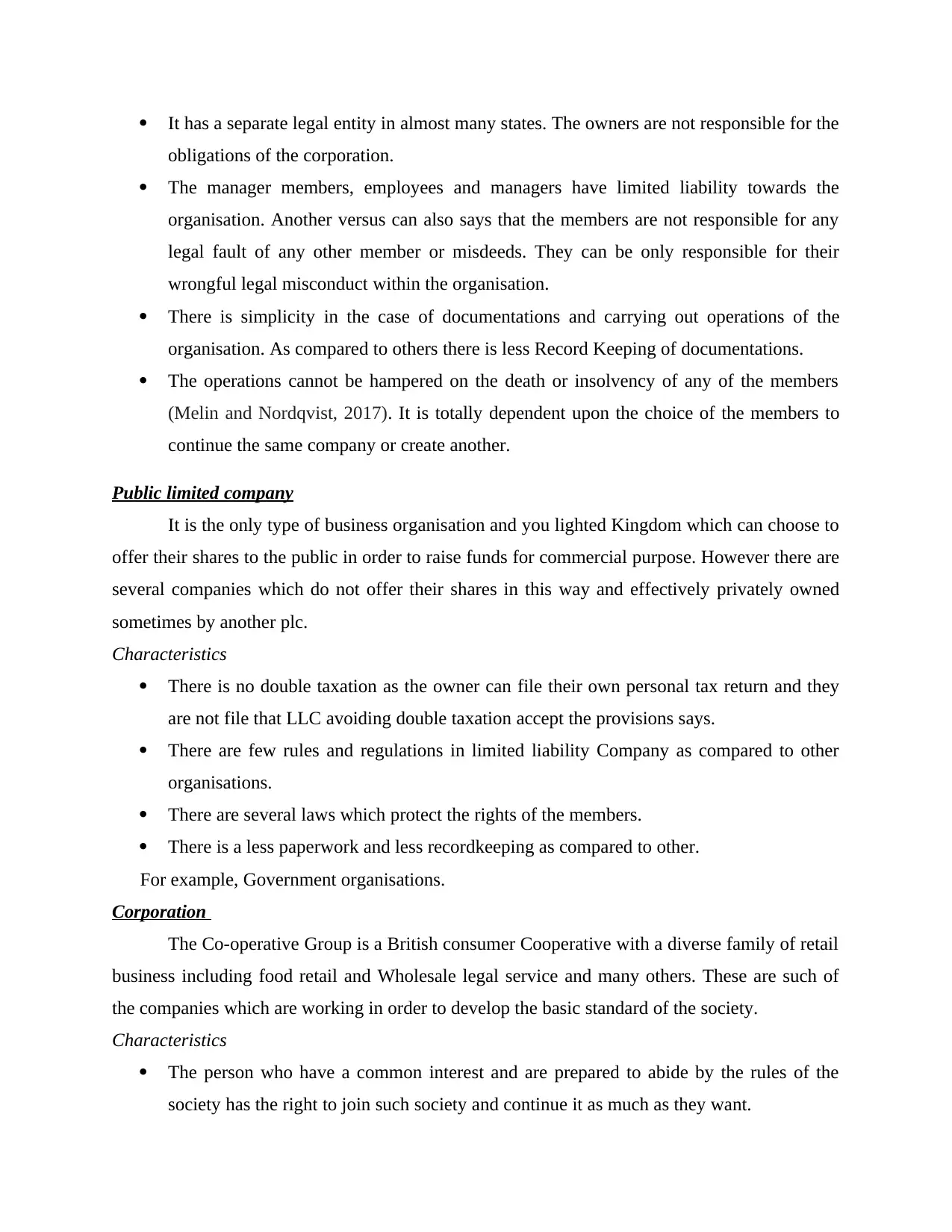
It has a separate legal entity in almost many states. The owners are not responsible for the
obligations of the corporation.
The manager members, employees and managers have limited liability towards the
organisation. Another versus can also says that the members are not responsible for any
legal fault of any other member or misdeeds. They can be only responsible for their
wrongful legal misconduct within the organisation.
There is simplicity in the case of documentations and carrying out operations of the
organisation. As compared to others there is less Record Keeping of documentations.
The operations cannot be hampered on the death or insolvency of any of the members
(Melin and Nordqvist, 2017). It is totally dependent upon the choice of the members to
continue the same company or create another.
Public limited company
It is the only type of business organisation and you lighted Kingdom which can choose to
offer their shares to the public in order to raise funds for commercial purpose. However there are
several companies which do not offer their shares in this way and effectively privately owned
sometimes by another plc.
Characteristics
There is no double taxation as the owner can file their own personal tax return and they
are not file that LLC avoiding double taxation accept the provisions says.
There are few rules and regulations in limited liability Company as compared to other
organisations.
There are several laws which protect the rights of the members.
There is a less paperwork and less recordkeeping as compared to other.
For example, Government organisations.
Corporation
The Co-operative Group is a British consumer Cooperative with a diverse family of retail
business including food retail and Wholesale legal service and many others. These are such of
the companies which are working in order to develop the basic standard of the society.
Characteristics
The person who have a common interest and are prepared to abide by the rules of the
society has the right to join such society and continue it as much as they want.
obligations of the corporation.
The manager members, employees and managers have limited liability towards the
organisation. Another versus can also says that the members are not responsible for any
legal fault of any other member or misdeeds. They can be only responsible for their
wrongful legal misconduct within the organisation.
There is simplicity in the case of documentations and carrying out operations of the
organisation. As compared to others there is less Record Keeping of documentations.
The operations cannot be hampered on the death or insolvency of any of the members
(Melin and Nordqvist, 2017). It is totally dependent upon the choice of the members to
continue the same company or create another.
Public limited company
It is the only type of business organisation and you lighted Kingdom which can choose to
offer their shares to the public in order to raise funds for commercial purpose. However there are
several companies which do not offer their shares in this way and effectively privately owned
sometimes by another plc.
Characteristics
There is no double taxation as the owner can file their own personal tax return and they
are not file that LLC avoiding double taxation accept the provisions says.
There are few rules and regulations in limited liability Company as compared to other
organisations.
There are several laws which protect the rights of the members.
There is a less paperwork and less recordkeeping as compared to other.
For example, Government organisations.
Corporation
The Co-operative Group is a British consumer Cooperative with a diverse family of retail
business including food retail and Wholesale legal service and many others. These are such of
the companies which are working in order to develop the basic standard of the society.
Characteristics
The person who have a common interest and are prepared to abide by the rules of the
society has the right to join such society and continue it as much as they want.
⊘ This is a preview!⊘
Do you want full access?
Subscribe today to unlock all pages.

Trusted by 1+ million students worldwide
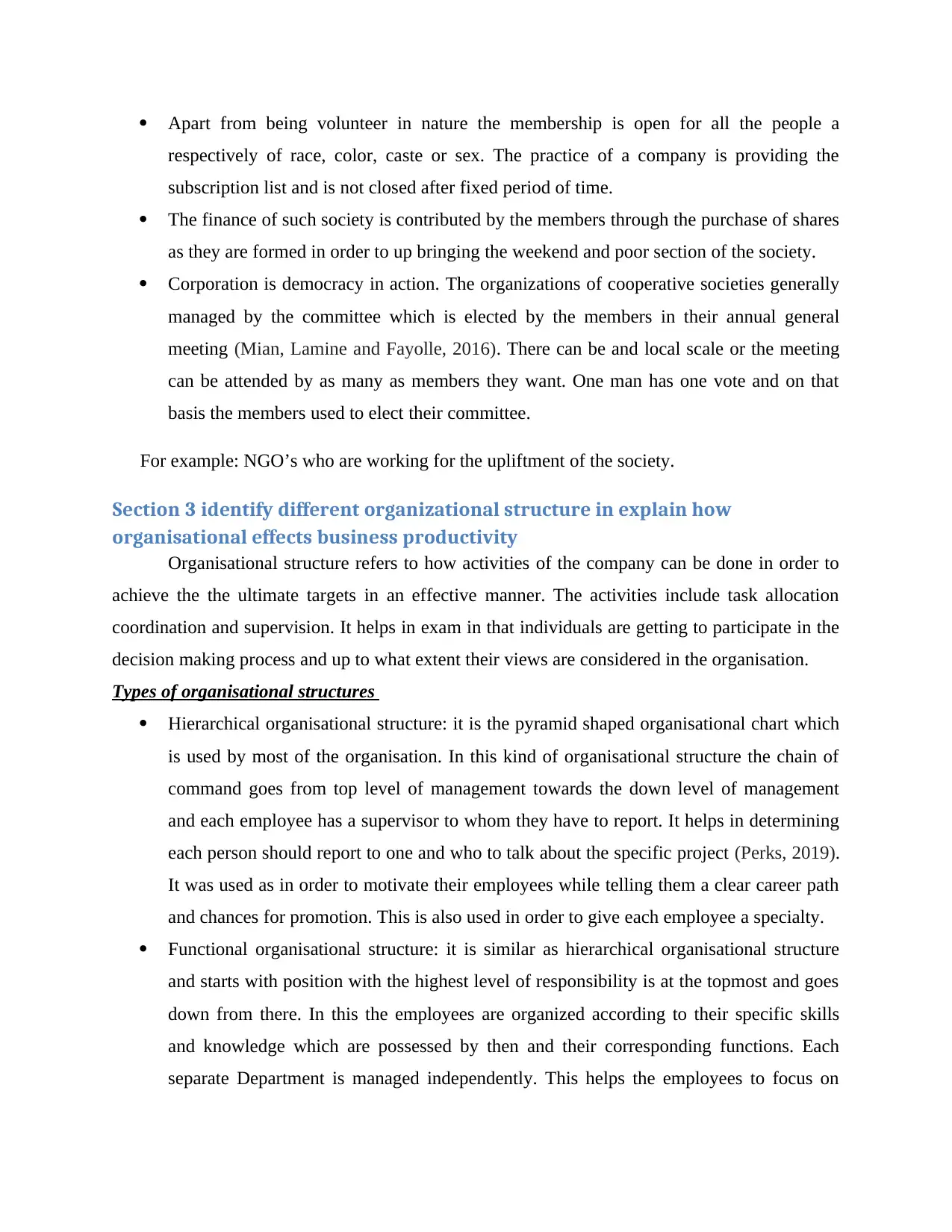
Apart from being volunteer in nature the membership is open for all the people a
respectively of race, color, caste or sex. The practice of a company is providing the
subscription list and is not closed after fixed period of time.
The finance of such society is contributed by the members through the purchase of shares
as they are formed in order to up bringing the weekend and poor section of the society.
Corporation is democracy in action. The organizations of cooperative societies generally
managed by the committee which is elected by the members in their annual general
meeting (Mian, Lamine and Fayolle, 2016). There can be and local scale or the meeting
can be attended by as many as members they want. One man has one vote and on that
basis the members used to elect their committee.
For example: NGO’s who are working for the upliftment of the society.
Section 3 identify different organizational structure in explain how
organisational effects business productivity
Organisational structure refers to how activities of the company can be done in order to
achieve the the ultimate targets in an effective manner. The activities include task allocation
coordination and supervision. It helps in exam in that individuals are getting to participate in the
decision making process and up to what extent their views are considered in the organisation.
Types of organisational structures
Hierarchical organisational structure: it is the pyramid shaped organisational chart which
is used by most of the organisation. In this kind of organisational structure the chain of
command goes from top level of management towards the down level of management
and each employee has a supervisor to whom they have to report. It helps in determining
each person should report to one and who to talk about the specific project (Perks, 2019).
It was used as in order to motivate their employees while telling them a clear career path
and chances for promotion. This is also used in order to give each employee a specialty.
Functional organisational structure: it is similar as hierarchical organisational structure
and starts with position with the highest level of responsibility is at the topmost and goes
down from there. In this the employees are organized according to their specific skills
and knowledge which are possessed by then and their corresponding functions. Each
separate Department is managed independently. This helps the employees to focus on
respectively of race, color, caste or sex. The practice of a company is providing the
subscription list and is not closed after fixed period of time.
The finance of such society is contributed by the members through the purchase of shares
as they are formed in order to up bringing the weekend and poor section of the society.
Corporation is democracy in action. The organizations of cooperative societies generally
managed by the committee which is elected by the members in their annual general
meeting (Mian, Lamine and Fayolle, 2016). There can be and local scale or the meeting
can be attended by as many as members they want. One man has one vote and on that
basis the members used to elect their committee.
For example: NGO’s who are working for the upliftment of the society.
Section 3 identify different organizational structure in explain how
organisational effects business productivity
Organisational structure refers to how activities of the company can be done in order to
achieve the the ultimate targets in an effective manner. The activities include task allocation
coordination and supervision. It helps in exam in that individuals are getting to participate in the
decision making process and up to what extent their views are considered in the organisation.
Types of organisational structures
Hierarchical organisational structure: it is the pyramid shaped organisational chart which
is used by most of the organisation. In this kind of organisational structure the chain of
command goes from top level of management towards the down level of management
and each employee has a supervisor to whom they have to report. It helps in determining
each person should report to one and who to talk about the specific project (Perks, 2019).
It was used as in order to motivate their employees while telling them a clear career path
and chances for promotion. This is also used in order to give each employee a specialty.
Functional organisational structure: it is similar as hierarchical organisational structure
and starts with position with the highest level of responsibility is at the topmost and goes
down from there. In this the employees are organized according to their specific skills
and knowledge which are possessed by then and their corresponding functions. Each
separate Department is managed independently. This helps the employees to focus on
Paraphrase This Document
Need a fresh take? Get an instant paraphrase of this document with our AI Paraphraser
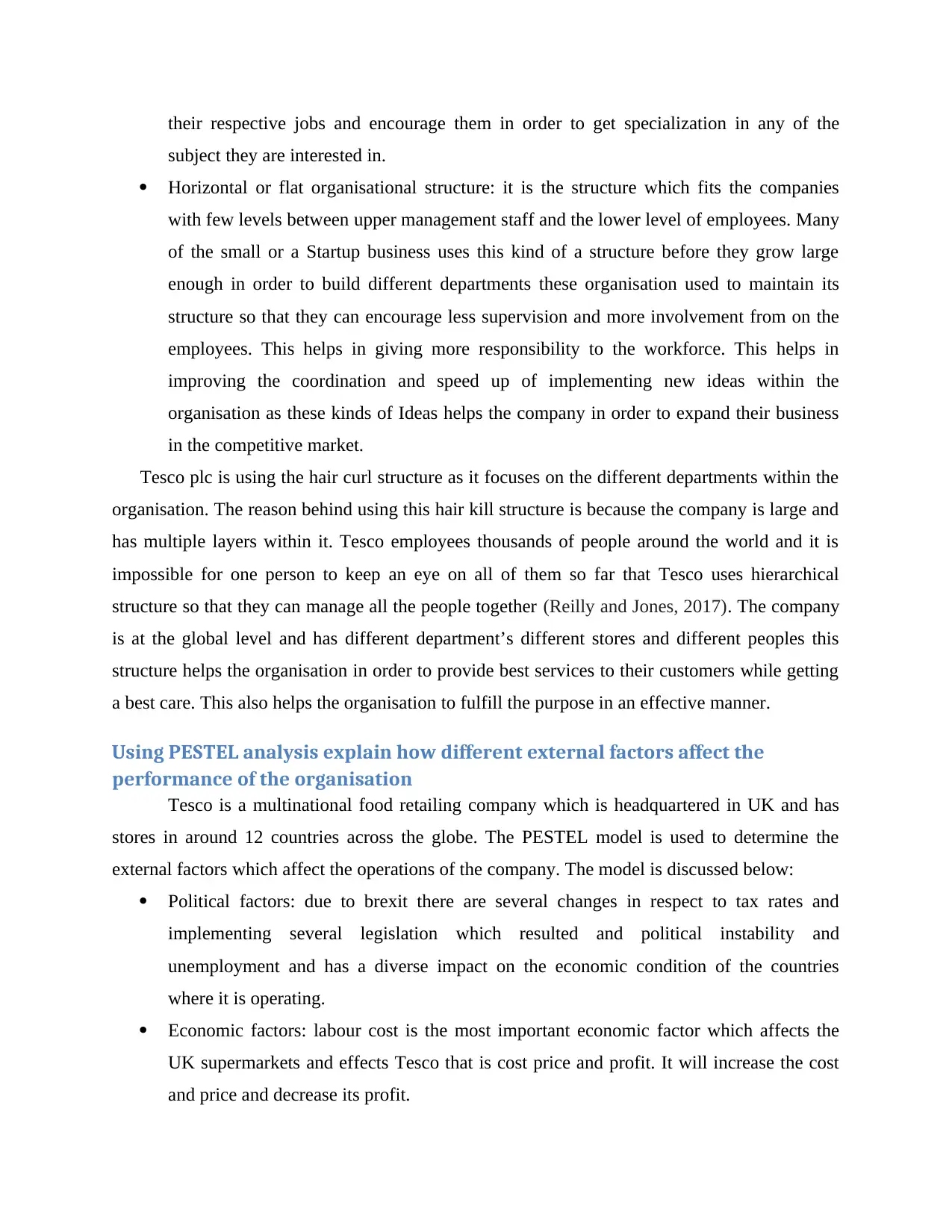
their respective jobs and encourage them in order to get specialization in any of the
subject they are interested in.
Horizontal or flat organisational structure: it is the structure which fits the companies
with few levels between upper management staff and the lower level of employees. Many
of the small or a Startup business uses this kind of a structure before they grow large
enough in order to build different departments these organisation used to maintain its
structure so that they can encourage less supervision and more involvement from on the
employees. This helps in giving more responsibility to the workforce. This helps in
improving the coordination and speed up of implementing new ideas within the
organisation as these kinds of Ideas helps the company in order to expand their business
in the competitive market.
Tesco plc is using the hair curl structure as it focuses on the different departments within the
organisation. The reason behind using this hair kill structure is because the company is large and
has multiple layers within it. Tesco employees thousands of people around the world and it is
impossible for one person to keep an eye on all of them so far that Tesco uses hierarchical
structure so that they can manage all the people together (Reilly and Jones, 2017). The company
is at the global level and has different department’s different stores and different peoples this
structure helps the organisation in order to provide best services to their customers while getting
a best care. This also helps the organisation to fulfill the purpose in an effective manner.
Using PESTEL analysis explain how different external factors affect the
performance of the organisation
Tesco is a multinational food retailing company which is headquartered in UK and has
stores in around 12 countries across the globe. The PESTEL model is used to determine the
external factors which affect the operations of the company. The model is discussed below:
Political factors: due to brexit there are several changes in respect to tax rates and
implementing several legislation which resulted and political instability and
unemployment and has a diverse impact on the economic condition of the countries
where it is operating.
Economic factors: labour cost is the most important economic factor which affects the
UK supermarkets and effects Tesco that is cost price and profit. It will increase the cost
and price and decrease its profit.
subject they are interested in.
Horizontal or flat organisational structure: it is the structure which fits the companies
with few levels between upper management staff and the lower level of employees. Many
of the small or a Startup business uses this kind of a structure before they grow large
enough in order to build different departments these organisation used to maintain its
structure so that they can encourage less supervision and more involvement from on the
employees. This helps in giving more responsibility to the workforce. This helps in
improving the coordination and speed up of implementing new ideas within the
organisation as these kinds of Ideas helps the company in order to expand their business
in the competitive market.
Tesco plc is using the hair curl structure as it focuses on the different departments within the
organisation. The reason behind using this hair kill structure is because the company is large and
has multiple layers within it. Tesco employees thousands of people around the world and it is
impossible for one person to keep an eye on all of them so far that Tesco uses hierarchical
structure so that they can manage all the people together (Reilly and Jones, 2017). The company
is at the global level and has different department’s different stores and different peoples this
structure helps the organisation in order to provide best services to their customers while getting
a best care. This also helps the organisation to fulfill the purpose in an effective manner.
Using PESTEL analysis explain how different external factors affect the
performance of the organisation
Tesco is a multinational food retailing company which is headquartered in UK and has
stores in around 12 countries across the globe. The PESTEL model is used to determine the
external factors which affect the operations of the company. The model is discussed below:
Political factors: due to brexit there are several changes in respect to tax rates and
implementing several legislation which resulted and political instability and
unemployment and has a diverse impact on the economic condition of the countries
where it is operating.
Economic factors: labour cost is the most important economic factor which affects the
UK supermarkets and effects Tesco that is cost price and profit. It will increase the cost
and price and decrease its profit.
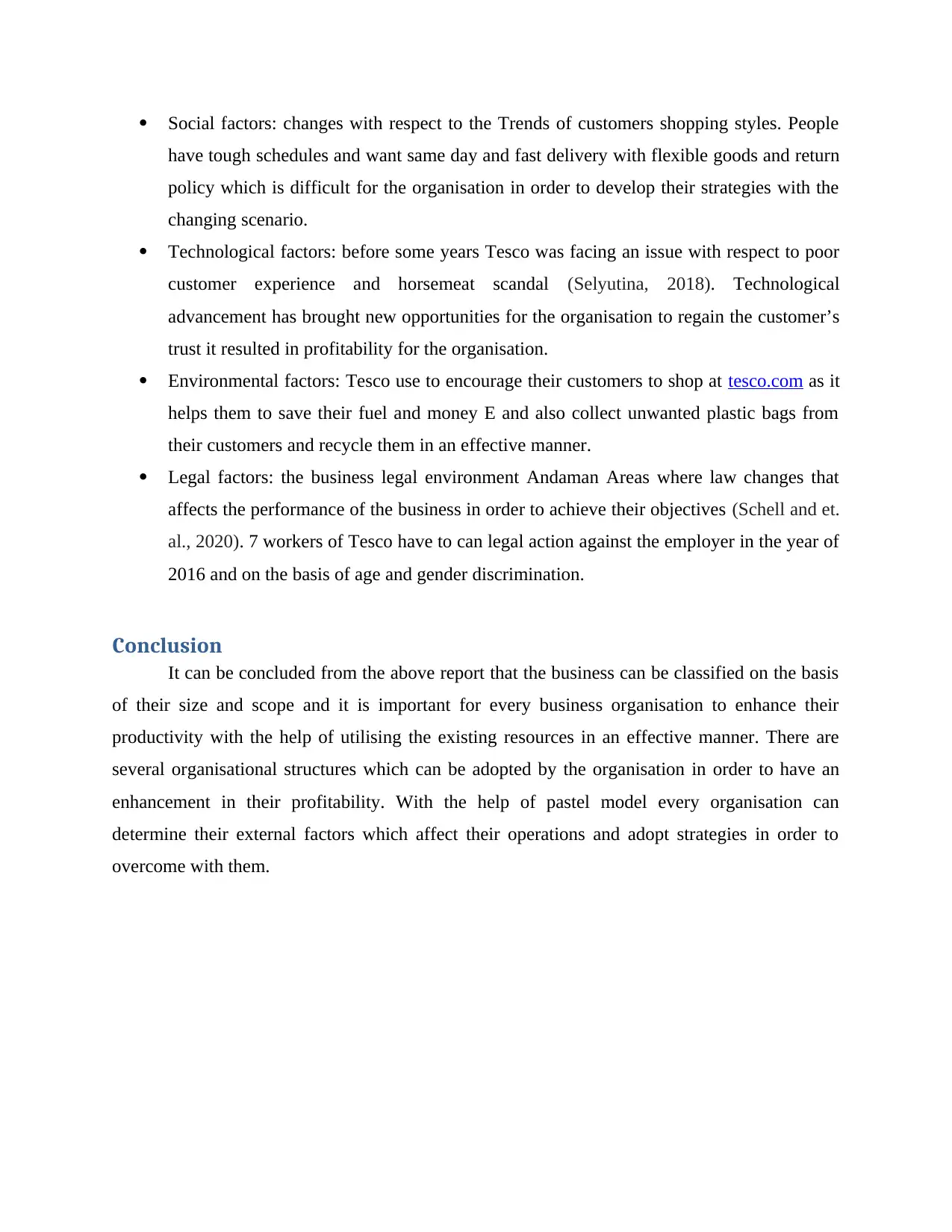
Social factors: changes with respect to the Trends of customers shopping styles. People
have tough schedules and want same day and fast delivery with flexible goods and return
policy which is difficult for the organisation in order to develop their strategies with the
changing scenario.
Technological factors: before some years Tesco was facing an issue with respect to poor
customer experience and horsemeat scandal (Selyutina, 2018). Technological
advancement has brought new opportunities for the organisation to regain the customer’s
trust it resulted in profitability for the organisation.
Environmental factors: Tesco use to encourage their customers to shop at tesco.com as it
helps them to save their fuel and money E and also collect unwanted plastic bags from
their customers and recycle them in an effective manner.
Legal factors: the business legal environment Andaman Areas where law changes that
affects the performance of the business in order to achieve their objectives (Schell and et.
al., 2020). 7 workers of Tesco have to can legal action against the employer in the year of
2016 and on the basis of age and gender discrimination.
Conclusion
It can be concluded from the above report that the business can be classified on the basis
of their size and scope and it is important for every business organisation to enhance their
productivity with the help of utilising the existing resources in an effective manner. There are
several organisational structures which can be adopted by the organisation in order to have an
enhancement in their profitability. With the help of pastel model every organisation can
determine their external factors which affect their operations and adopt strategies in order to
overcome with them.
have tough schedules and want same day and fast delivery with flexible goods and return
policy which is difficult for the organisation in order to develop their strategies with the
changing scenario.
Technological factors: before some years Tesco was facing an issue with respect to poor
customer experience and horsemeat scandal (Selyutina, 2018). Technological
advancement has brought new opportunities for the organisation to regain the customer’s
trust it resulted in profitability for the organisation.
Environmental factors: Tesco use to encourage their customers to shop at tesco.com as it
helps them to save their fuel and money E and also collect unwanted plastic bags from
their customers and recycle them in an effective manner.
Legal factors: the business legal environment Andaman Areas where law changes that
affects the performance of the business in order to achieve their objectives (Schell and et.
al., 2020). 7 workers of Tesco have to can legal action against the employer in the year of
2016 and on the basis of age and gender discrimination.
Conclusion
It can be concluded from the above report that the business can be classified on the basis
of their size and scope and it is important for every business organisation to enhance their
productivity with the help of utilising the existing resources in an effective manner. There are
several organisational structures which can be adopted by the organisation in order to have an
enhancement in their profitability. With the help of pastel model every organisation can
determine their external factors which affect their operations and adopt strategies in order to
overcome with them.
⊘ This is a preview!⊘
Do you want full access?
Subscribe today to unlock all pages.

Trusted by 1+ million students worldwide
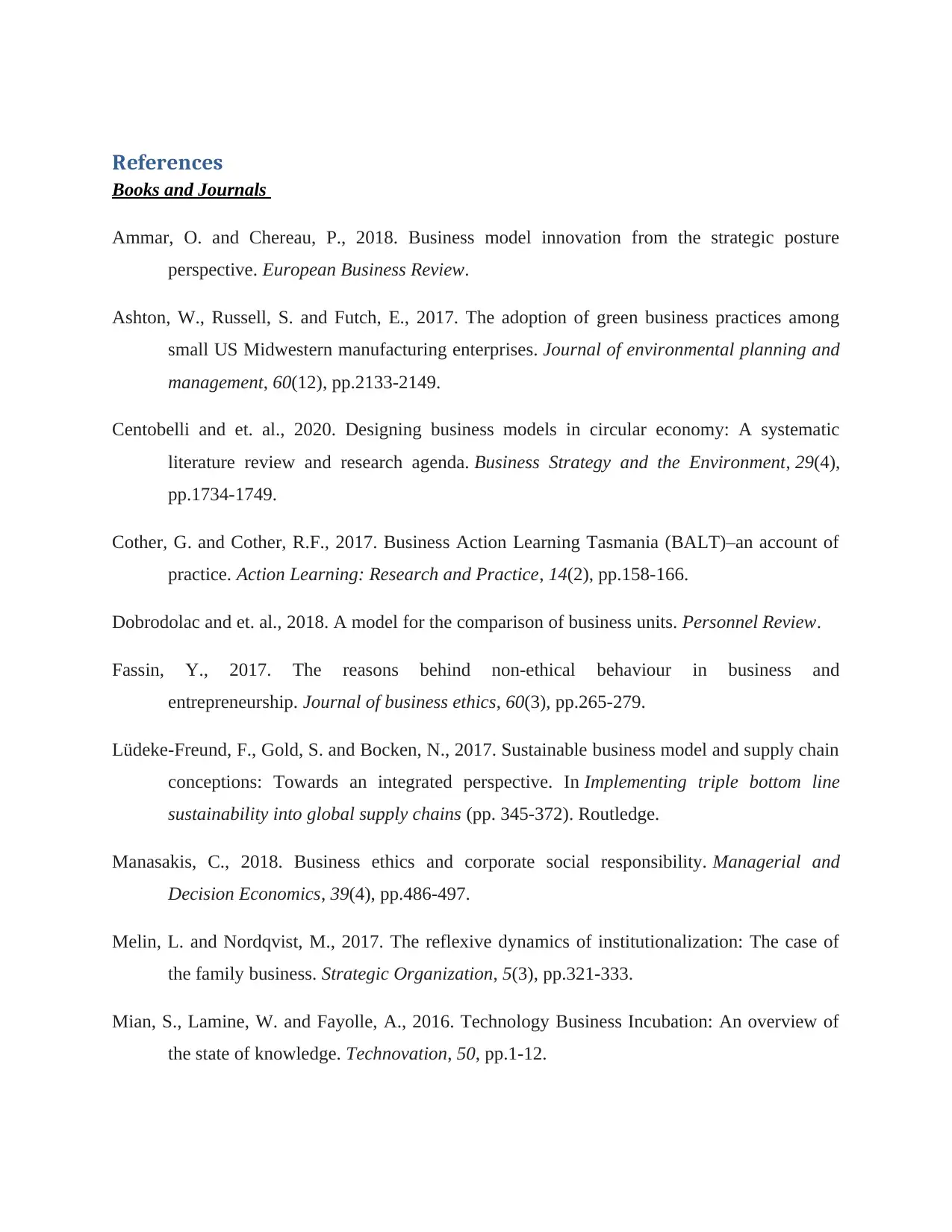
References
Books and Journals
Ammar, O. and Chereau, P., 2018. Business model innovation from the strategic posture
perspective. European Business Review.
Ashton, W., Russell, S. and Futch, E., 2017. The adoption of green business practices among
small US Midwestern manufacturing enterprises. Journal of environmental planning and
management, 60(12), pp.2133-2149.
Centobelli and et. al., 2020. Designing business models in circular economy: A systematic
literature review and research agenda. Business Strategy and the Environment, 29(4),
pp.1734-1749.
Cother, G. and Cother, R.F., 2017. Business Action Learning Tasmania (BALT)–an account of
practice. Action Learning: Research and Practice, 14(2), pp.158-166.
Dobrodolac and et. al., 2018. A model for the comparison of business units. Personnel Review.
Fassin, Y., 2017. The reasons behind non-ethical behaviour in business and
entrepreneurship. Journal of business ethics, 60(3), pp.265-279.
Lüdeke-Freund, F., Gold, S. and Bocken, N., 2017. Sustainable business model and supply chain
conceptions: Towards an integrated perspective. In Implementing triple bottom line
sustainability into global supply chains (pp. 345-372). Routledge.
Manasakis, C., 2018. Business ethics and corporate social responsibility. Managerial and
Decision Economics, 39(4), pp.486-497.
Melin, L. and Nordqvist, M., 2017. The reflexive dynamics of institutionalization: The case of
the family business. Strategic Organization, 5(3), pp.321-333.
Mian, S., Lamine, W. and Fayolle, A., 2016. Technology Business Incubation: An overview of
the state of knowledge. Technovation, 50, pp.1-12.
Books and Journals
Ammar, O. and Chereau, P., 2018. Business model innovation from the strategic posture
perspective. European Business Review.
Ashton, W., Russell, S. and Futch, E., 2017. The adoption of green business practices among
small US Midwestern manufacturing enterprises. Journal of environmental planning and
management, 60(12), pp.2133-2149.
Centobelli and et. al., 2020. Designing business models in circular economy: A systematic
literature review and research agenda. Business Strategy and the Environment, 29(4),
pp.1734-1749.
Cother, G. and Cother, R.F., 2017. Business Action Learning Tasmania (BALT)–an account of
practice. Action Learning: Research and Practice, 14(2), pp.158-166.
Dobrodolac and et. al., 2018. A model for the comparison of business units. Personnel Review.
Fassin, Y., 2017. The reasons behind non-ethical behaviour in business and
entrepreneurship. Journal of business ethics, 60(3), pp.265-279.
Lüdeke-Freund, F., Gold, S. and Bocken, N., 2017. Sustainable business model and supply chain
conceptions: Towards an integrated perspective. In Implementing triple bottom line
sustainability into global supply chains (pp. 345-372). Routledge.
Manasakis, C., 2018. Business ethics and corporate social responsibility. Managerial and
Decision Economics, 39(4), pp.486-497.
Melin, L. and Nordqvist, M., 2017. The reflexive dynamics of institutionalization: The case of
the family business. Strategic Organization, 5(3), pp.321-333.
Mian, S., Lamine, W. and Fayolle, A., 2016. Technology Business Incubation: An overview of
the state of knowledge. Technovation, 50, pp.1-12.
Paraphrase This Document
Need a fresh take? Get an instant paraphrase of this document with our AI Paraphraser
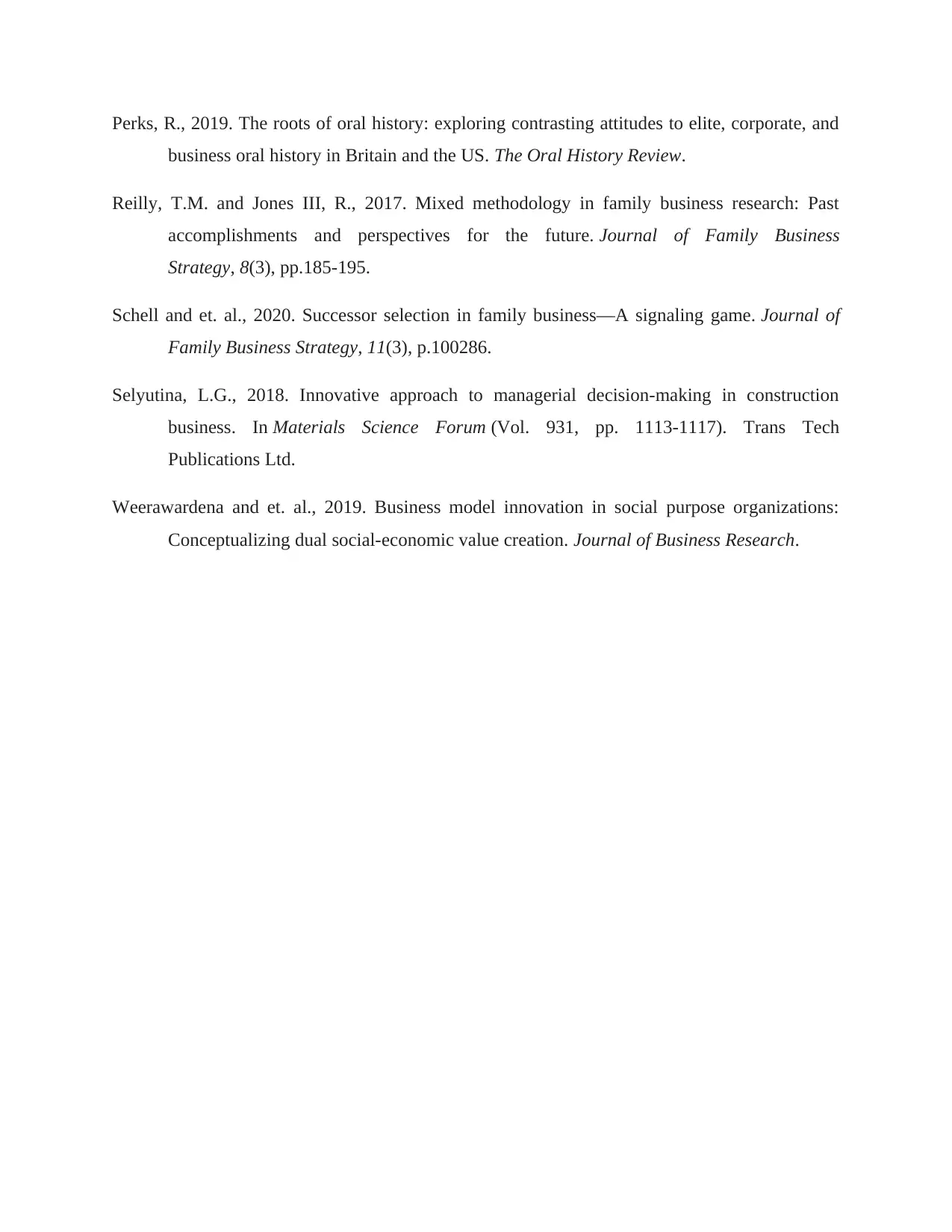
Perks, R., 2019. The roots of oral history: exploring contrasting attitudes to elite, corporate, and
business oral history in Britain and the US. The Oral History Review.
Reilly, T.M. and Jones III, R., 2017. Mixed methodology in family business research: Past
accomplishments and perspectives for the future. Journal of Family Business
Strategy, 8(3), pp.185-195.
Schell and et. al., 2020. Successor selection in family business—A signaling game. Journal of
Family Business Strategy, 11(3), p.100286.
Selyutina, L.G., 2018. Innovative approach to managerial decision-making in construction
business. In Materials Science Forum (Vol. 931, pp. 1113-1117). Trans Tech
Publications Ltd.
Weerawardena and et. al., 2019. Business model innovation in social purpose organizations:
Conceptualizing dual social-economic value creation. Journal of Business Research.
business oral history in Britain and the US. The Oral History Review.
Reilly, T.M. and Jones III, R., 2017. Mixed methodology in family business research: Past
accomplishments and perspectives for the future. Journal of Family Business
Strategy, 8(3), pp.185-195.
Schell and et. al., 2020. Successor selection in family business—A signaling game. Journal of
Family Business Strategy, 11(3), p.100286.
Selyutina, L.G., 2018. Innovative approach to managerial decision-making in construction
business. In Materials Science Forum (Vol. 931, pp. 1113-1117). Trans Tech
Publications Ltd.
Weerawardena and et. al., 2019. Business model innovation in social purpose organizations:
Conceptualizing dual social-economic value creation. Journal of Business Research.
1 out of 11
Related Documents
Your All-in-One AI-Powered Toolkit for Academic Success.
+13062052269
info@desklib.com
Available 24*7 on WhatsApp / Email
![[object Object]](/_next/static/media/star-bottom.7253800d.svg)
Unlock your academic potential
Copyright © 2020–2025 A2Z Services. All Rights Reserved. Developed and managed by ZUCOL.




